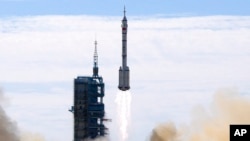A Chinese rocket, according to astronomers, is expected to crash into the moon on March 4. It is the latest example of China’s presence in space. News of the predicted crash comes after Beijing released a development blueprint for satellite improvements, deep-space exploration and putting more people in orbit.
Analysts expect Beijing to reach many of the goals outlined in its five-year plan for the development of outer space despite the odd mishap, according to experts.
China’s space program stands to rival those of Russia and the United States, especially in terms of commercializing space technology, they add.
“China is something to look at seriously in terms of increasing competitiveness,” said Marco Caceres, director of space studies at the Teal Group market analysis firm. “Part of that is that the U.S. was ahead by so much that countries like China, where their economies are growing faster, they’re simply catching up.”
Past meets future
China launched its first satellite in 1970 and put its first human in space in 2003, becoming the world’s third nation, after Russia and the United States, to reach that milestone. In 2019, China’s spacecraft made a historic landing on the far side of the moon. Beijing is in the process of adding onto its Tiangong space station later this year.
China is excluded from the International Space Station, a cooperative operation among Europe, the United States, Russia, Canada and Japan, due to U.S. national security concerns.
Over the next five years, Beijing’s space program will place people in space on “long-term assignments” for scientific research, complete findings on Mars and explore the Jupiter system, according to China's Space Program: A 2021 Perspective.
The coming half-decade will see improvements as well in the capacity of space transport systems, and China will “continue to improve its space infrastructure” through integration of remote sensing, communications, navigation and satellite positioning technologies, the document says.
China will probably realize its five-year goals because it has been working on them for a decade or more, with plenty of government funding, analysts say.
The January report effectively “bundles” together what’s already taking shape, said Richard Bitzinger, defense analyst with the Defense Budget Project, a research nonprofit in Washington. It’s technically possible that China could mine ore on an asteroid, Bitzinger said, though the job would require complex anchoring and drilling work.
A lot of the blueprint goals are meant to exude peaceful intent and a positive international image, he added. “Most manned space programs are symbolic,” Bitzinger said. “From an economic sense, they’re a loss leader, but from a sense of demonstrating power, they’re perfect for that.”
The blueprint says future Chinese space missions will remain “peaceful,” despite suspicion in Washington that the Chinese space program will be directed toward military purposes.
Commercial momentum
Progress in the Chinese space program has allowed China to become what Caceres describes as more “aggressive” than the United States in marketing satellites and modern launch services. Its budget probably grows faster than NASA’s, he added. Chinese space-related gear can be found in Africa, Asia and Latin America, the analyst said.
Countries such as Australia and Japan already use Chinese space-based remote sensing data after natural disasters. Russia and China tentatively agreed in September to open a joint lunar research base.
“China calls on all countries to work together to build a global community of (a) shared future and carry out in-depth exchanges and cooperation in outer space on the basis of equality, mutual benefit, peaceful utilization, and inclusive development,” the Chinese Embassy in Washington told VOA on Wednesday.
Some of the countries closest to China geographically may still hold out for U.S. space technology despite China’s willingness to engage, said Alan Chong, associate professor at the Singapore-based S. Rajaratnam School of International Studies.
The government of Myanmar, for example, resents China over infrastructure debt and projects that people see as irrelevant to their lives, the U.S.-based Center for Strategic and International Studies has found.
“I think the situation is fluid, and I wouldn’t say that Southeast Asia will be comfortably in the Chinese orbit yet," Chong said. "It has of course never been friendlier with China, over the past 15 years or so, but I think the game is not over for the United States."




